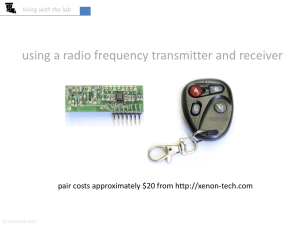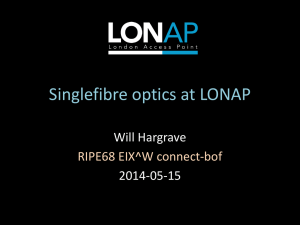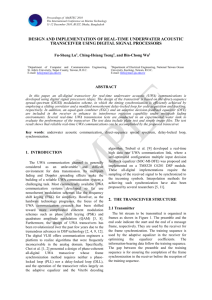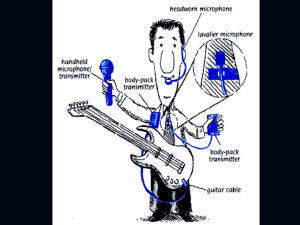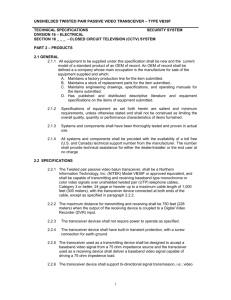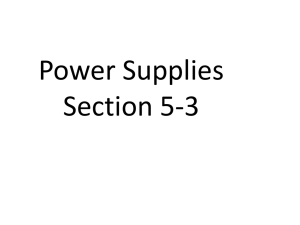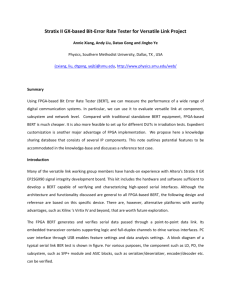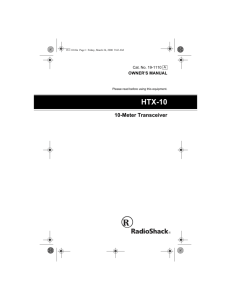RF MICROELECTRONICS BEHZAD RAZAVI
advertisement
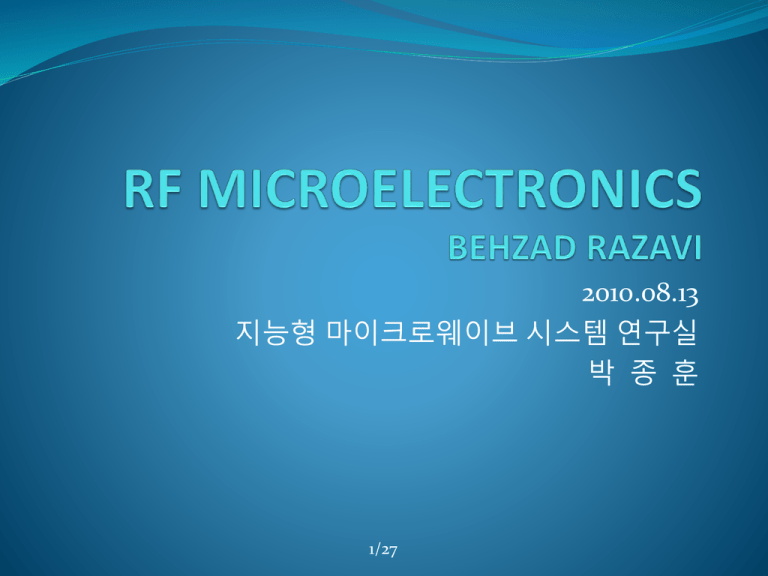
2010.08.13 지능형 마이크로웨이브 시스템 연구실 박 종 훈 1/27 Contents Ch.5 Transceiver Architecture 5.1 General Considerations 5.2 Receiver Architectures 5.3 Transmitter Architectures 5.3.1 Direct-Conversion Transmitters 5.3.2 Two-Step Transmitters 5.4 Transceiver Performance Tests 5.5 Case Studies 5.5.1 Motorola’s FM Receiver 5.5.2 Philips’ Pager Receiver 5.5.3 Philips’ DECT Transceiver 5.5.4 Lucent Technologies’ GSM Transceiver 5.5.5 Philips’ GSM Transceiver 2/27 5.3 Transmitter Architectures Transmitter Performances Modulation, Upconversion, Power amplification Modulation + Upconversion Transmitter VS Receiver Transmitter : Only a few forms Receiver : Variety of approaches invented Relaxed in transmitters than in receivers Noise, interference rejection, band selectivity 3/27 5.3 Transmitter Architectures 1. Baseband / RF interface 1) FM System Baseband signal is conditioned By filter and/or a variable-gain stage, compensating for manufacturing variations in the VCO characteristic Because Output spectrum Oscillator must be stabilized by feedback loop Frequency synthesizer Baseband signal modulated by VCO 4/27 5.3 Transmitter Architectures 2) Digital phase modulation system Data pulses must be shaped To minimize intersymbol interference and/or limit the signal bandwidth 5/27 5.3 Transmitter Architectures Bandpass pulse shaping 6/27 5.3 Transmitter Architectures GMSK h(t) : Impulse response of a Gaussian filter -> Impacts the channel bandwidth -> Prove more accurate filter 7/27 5.3 Transmitter Architectures Phase and gain mismatch Ideal case Mismatch case 8/27 5.3 Transmitter Architectures 2. PA/Antenna Interface Transmitter output must pass through a duplexer filter or a TDD switch Duplexer filters : 2 to 3dB -> Dissipating 30 to 50% of PA output power in the form of heat Example PA provides 1W of power -> 300mW is wasted in the filter PA efficiency rarely exceeds 50% 600mW drained from the supply to filter TDD switch : 0.5 and 1dB loss -> higher overall efficiency 9/27 5.3.1 Direct-Conversion Transmitters 1. Direct conversion Transmitted carrier frequency = Local oscillator frequency Modulation and upconversion occur in the same circuit Matching Network Provide maximum power transfer to the antenna and filter outof-band components Noise of the mixers is much less critical Signal is sufficiently strong 10/27 5.3.1 Direct-Conversion Transmitters Drawback Disturbance of the transmit local oscillator by the power amplifier PA output is a modulated waveform with high power and a spectrum centered around the LO frequency Injection pulling or injection locking Worsens if the PA is turned on and off ( to save power) 11/27 5.3.1 Direct-Conversion Transmitters Solution Offsetting the LO frequency Adding or subtracting the output frequency of another oscillator 12/27 5.3.2 Two-Step Transmitters Circumventing the problem of LO pulling Baseband modulate W1 ( Intermediate Frequency) 13/27 5.3.2 Two-Step Transmitters Advantage Quadrature modulation is performed at lower frequencies I and Q matching is superior Less cross-talk Limit the transmitted noise and spurs in adjacent channels Difficulty Second upconversion must reject the unwanted sideband by a large factor (50 to 60dB) Wanted and unwanted sidebands with equal magnitudes Because of higher center frequency, filter is typically a passive, relatively expensive off-chip device 14/27 5.4 Transceiver Performance tests 1. Sensitivity and Dynamic Range In most systems, a minimum detectable signal level is specified •In-band intermodulation test •Output carrier-to(noise+intermodulation) •[C/N+I)] must not far below 9dB 15/27 5.4 Transceiver Performance tests •Out-of-band and second-order intermodulation test •C/(N+I) of the IF signal must exceed 9dB •Out-of-band cross modulation •C/(N+I) of greater than 9dB 16/27 5.4 Transceiver Performance tests 2. Unwanted Emission Modulation Mask Below which the transmitter output spectrum must lie Standard to ensure negligible radiation in adjacent channels Mask ACP IS-54 standards : -26dBc IS-95 standards : -42dBc 17/27 5.5 Case Studies 5.5.1 Motorola’s FM Receiver 5.5.2 Philips’ Pager Receiver 5.5.3 Philips’ DECT Transceiver 5.5.4 Lucent Technologies’ GSM Transceiver 5.5.5 Philips’ GSM Transceiver 18/27 5.5.1 Motorola’s FM Receiver 50Mhz±10.7MHz Reject interferers Reasonable noise figure and linearity Remove some image Channel Selection Amplified nonlinearly Walkie-talkies or first-generation cordless phone (50MHz) No LNA and Image rejection filter Required some external components 19/27 Matching, Single-ended to differential Spilit RF signal ( LO simplicity) Channel Selection 5.5.2 Philips’ Pager Receiver UAA2080T is a single-chip bipolar homodyne receiver (FSK) Required some external components Local Oscillator 470MHz (frequency doubler : 235MHz X 2) Actually operates at the third harmonic of a 78.3MHz crstal Received single fixed freq. -> freq. need not be variable -> eliminating synthersizers compact, low-power But cannot easily generate precise quadrature phases -> Seperation in the RF path 20/27 5.5.2 Philips’ Pager Receiver Bypolar Technology Minimize the I/Q imbalance Even-order distortion is suppressed (Differential circuits) LO leakage is reduced by cascode configuration (LNA, mixers) Limited dynamic range is less serious FSK : High frequency -> High SNR Bit error rate can be as high as 3% Because redundancies are incorporated in the data stream to correct errors 21/27 Mismatchlimited 5.5.3 Philips’ DECT Transceiver Matching, Converted to Differential 110MHz SAW filter TDD 9.8MHz 1.89GHz 2nd IF is much higher than MC3362 because the DECT channel bandwidth of 1.7MHz requires a sufficiently high center frequency 22/27 5.5.3 Philips’ DECT Transceiver Blind slot Receive and transmit modes are separated by blind slot Stabilize the frequency Approximately 250μs to settle, a blind slot precedes the signal transmission to avoid leakage of the spectrum into adjacent channels 23/27 5.5.3 Philips’ DECT Transceiver Error Problem Separation from the feedback loop, the VCO control line experiences finite charge injection errors PA is turned on, its input impedance varies thereby changin the load impedance and hence the oscillation frequency of the VCO PA active current, about 250mA, drops the battery voltage by a few hundred millivolts, affecting the VCO output frequency The sum of these errors must not exceed 50kHz 24/27 5.5.4 Lucent Technologies’ GSM Transceiver Channel Selection 900Mhz To avoid VCO pulling Lucent Microelectronics(formerly AT&T Microelectronics) offers a single-chip solution that, along with a low-noise amplifier and a power amplifier Requires only two external filters But the IF SAW device tends to have higher loss(and higher cost) if it must filter adjacent channels to sufficiently low levels 25/27 Allow the use of two low-cost, lossy image-reject filter 5.5.5 Philips’ GSM Transceiver Signal : 700Mhz Image : 1.7GHz 900Mhz 1.3GHz Integrated fifth-order low-pass filters -> IF SAW filters has relaxed 1.3GHz Oscillator, Suppressing the unwanted sideband -> LC Filter has relaxed Philips’ semiconductor offers a pair of RF and IF chips for GSM transceivers 26/27 5.5.3 Philips’ DECT Transceiver Only two oscillators Simplifying the prediction of various spurs Because the system is time division(and frequency division) duplexed, making it possible to share the oscillators between the two paths 27/27


